Mastering the Art of Teaching Your Parrot to Talk
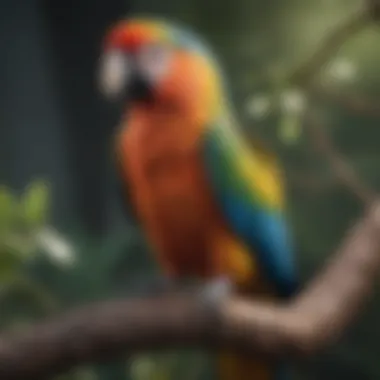
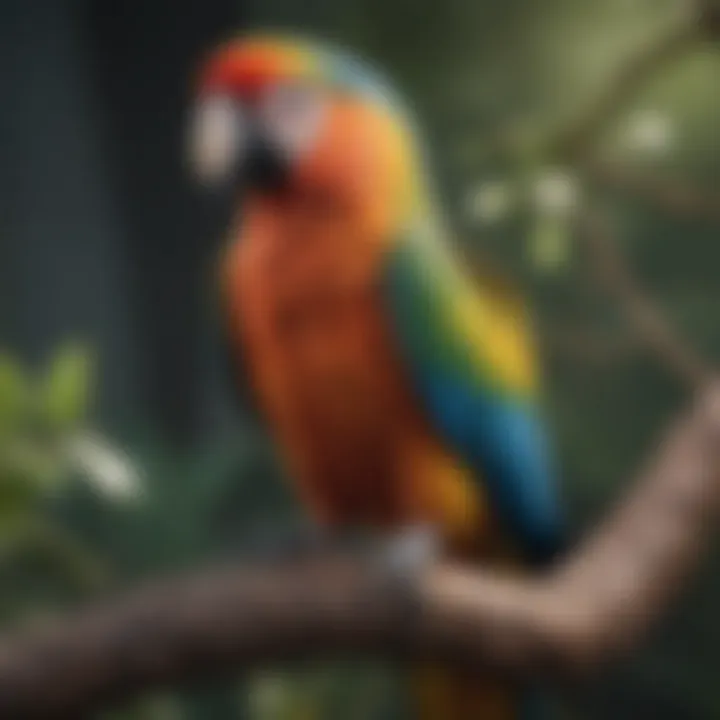
Intro
Teaching a parrot to talk can be a fascinating challenge for any avian enthusiast. Parrots possess impressive cognitive abilities, and with the right techniques, they can develop a delightful vocabulary. To embark on this journey, it helps to have a deep understanding of their needs and behaviors. This guide aims to provide you with those insights, enhancing both communication and connection with your feathered friend.
Care Tips
When it comes to teaching your parrot to talk, daily care routines play a significant role. A parrot that is healthy and content is likely to engage more during training.
Daily Care Routines
Daily care routines for your parrot should include feeding, social interaction, and mental stimulation. Ensure you feed them a balanced diet that suits their species, provide opportunities for them to interact, and engage them in activities that challenge their intellect. Consistency in your daily routines will create a stable environment, fostering better learning experiences for your pet.
Cage Setup and Maintenance
An appropriate cage setup should cater to your parrot's size and species. It is essential to provide enough space for movement. The cage should include perches of various thickness, toys, and areas where they can interact with the outside world. Regular maintenance, including immediate cleaning of food and water bowls, will promote hygiene.
Hygiene and Cleaning Practices
Regular cleaning cannot be overlooked. Dirty cages can lead to health issues. Use bird-safe cleaners and approach the task with diligence. If specific bedding materials harbor bacteria, change them to ensure a safe living space for your parrot.
Seasonal Care Adjustments
Adjust your care depending on the seasons. In winter, parrots may need additional warmth and humidity; while in summer, ensure they have access to shaded areas and fresh water to stay hydrated.
Behavioral Insights
Understanding a parrot's body language can significantly enhance your interaction. Birds communicate not just through vocalizations but also through their movements and postures.
Understanding Bird Body Language
Pay attention to a parrot's tail feathers, head positions, and eye movement. Each detail conveys distinct emotions that inform how they feel about their environment and interactions with humans. Recognizing these signals can help avert potential stressors.
Common Behavioral Issues and Solutions
Common issues like biting, screaming, or feather plucking can be detrimental to training. Identifying the root cause—such as boredom or stress—is essential. Implement enrichment activities to reduce restless behavior and promote a harmonious living environment.
Positive Reinforcement Techniques
Using positive reinforcement can effectively encourage desired behaviors. Reward successful vocalizations with treats or praise, building a strong motivator for your parrot to interact more openly.
Social Interaction Needs
Parrots are inherently social creatures. Loneliness can lead to behavioral problems. Schedule regular time to spend with your parrot, either through play or conversation, to fulfill their social interaction needs.
Nutrition Guides
Nutrition is the foundation for a healthy parrot, which can directly impact its ability to learn to talk.
Essential Diet Components
A suitable diet for your parrot typically blends pellets, fresh fruits, and vegetables. Different species have slightly varied dietary requirements, so it's vital to inform yourself about your specific parrot's needs.
Safe and Toxic Foods
Awareness of safe versus toxic foods is crucial. Always consult resources or avian veterinarians to create a safe menu for your parrot. Avoid items like avocado, chocolate, and certain seeds that can harm your bird.
Supplements and Treats
Biologically, providing appropriate supplements can enhance your bird's well-being. Occasional treats, if nutritious, can incentivize training without turning it into a diet detrimental.
Feeding Strategies for Different Species
Understanding the dietary specifics of different parrot species ensures better health outcomes. Familiarize yourself with these details through reliable sites; it is essential.
Wellness and Health
Regular health oversight broadens the scope for teaching parrots to communicate.
Routine Health Checkups
Ensure you schedule regular visits with an avian vet to monitor your parrot's health. Routine checkups create an opportunity to catch potential illnesses early, keeping your bird in peak condition for training.
Identifying Symptoms of Illness
Pay attention to common symptoms such as excessive lethargy, changes in appetite, or alterations in vocalization, which may indicate health issues needing prompt attention.
Preventative Care and Vaccinations
Preventative measures boost your parrot's immunity against common diseases. Consult your veterinarian to develop a vaccine schedule tailored to your parrot's health needs.
Mental and Emotional Well-being
Maintaining emotional health plays a crucial role in fostering a well-behaved bird willing to engage in speech. Interactive toys and sufficient stimulation reduce anxiety and allow for a happier environment for learning.
Enriching Activities
Incorporating enriching activities can spark an innate interest in communication from your parrot.
Toys and Playtime Ideas
Toys can vary based on your parrot’s preferences. Offer climbing structures, foraging toys, and mirrors to stimulate curiosity and observation.
Training and Tricks
Training sessions should be brief and playful. A relaxed atmosphere allows better focus from your parrot. Tricks encourage engagement and can foster a sense of accomplishment for both bird and owner.
Outdoor Activities and Interaction
Taking your parrot outdoors in a secure aviary or using harnesses promotes excitement. Safely experiencing the outside world can improve their mood and lead to curious, vocal behaviors as they seek to mimic what they experience.
DIY Projects for Mental Stimulation
Engage in DIY projects like building toys or creating small obstacle courses. These activities keep both you and your parrot engaged while fostering direct paths to communication development.
Teaching a parrot to talk is an ongoing process. Patience and warmth enhance the experience, offering meaningful interaction that could strengthen your bond with your avian companion. Reach out to communities on platforms like Reddit or Facebook for shared experiences and additional guidance as you embark on this rewarding adventure.
Preface to Parrot Communication
Communication is a vital aspect of any interaction, especially between humans and their avian companions. For parrots, vocalization serves as a primary means of expression. Understanding parrot communication enhances the owner's capacity to engage effectively and nurture a rich relationship. Knowledge about their vocal patterns paves the way for successful training.
Understanding Parrot Vocalizations
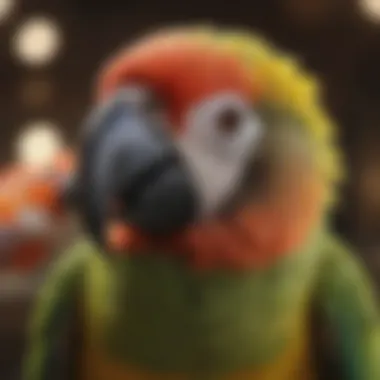

Parrot vocalizations range from simple sounds to complex calls. Each sound carries meaning, shaped by context and individual personality. Parrots often mimic sounds from their environment, including human speech. This mimicking is not mere imitation; it is a form of social interaction. Different species may exhibit varying vocal abilities.
High-pitched squawks usually signify excitement or alertness, while softer tones may reflect comfort or contentment. Paid attention can reveal what particular sounds mean. Having this knowledge is beneficial when attempting to teach a parrot new words and phrases. By recognizing the subtle nuances of their vocalizations, owners can respond appropriately.
Importance of Talking for Parrots
Teaching a parrot to talk goes beyond the act of vocalization. Talking holds significance for the bird itself. Communication fosters social bonding, reduces feelings of loneliness, and encourages cognitive engagement. Parrots are social animals by nature, and vocalization is a means of belonging within their social groups.
Moreover, a talking parrot can be a source of companionship and joy. As parrots become accustomed to their owners’ voices, they may develop preferences for certain sounds or phrases. This shared experience reinforces the bond that forms between the owner and the parrot.
In summary, the ability to communicate effectively, both ways, enriches the lives of both human and parrot. Understanding the root of parrot vocalizations and the underlying purpose of talking is crucial. This sets the foundation for further training and successful interaction.
Choosing the Right Parrot Breed for Talking
Choosing the right parrot breed for talking is a fundamental aspect of teaching vocalization skills and securing a successful bond with your bird. All parrots have their own unique characteristics, but certain species are particularly known for their communication abilities. Purchasning the appropriate breed contributes greatly to a more effective learning experience. Not all parrot species can vocalize equally well, so doing thorough research is vital before acquiring a pet.
A parrot's propensity for human speech is tied to its individual inclinations as well as its natural instincts. Breeds more inclined to vocalization can make the plaza of teaching much more joyful. Some parrots have distinctly clear speaking abilities, while others may only be able to produce simple sounds or mimic basic phrases. This is paramount for potential parrot owners to consider before deciding on the species.
Overview of Speakable Species
Certain bird species exhibit stronger talking abilities than others, primarily shaped by their genetic makeup and environmental factors. These birds are generally better equipped for vocal communication effectively. The following species are widely recognized for their speaking abilities:
- African Grey Parrots: Often regarded as the best talkers, they can learn a vast array of words and phrases. Their intelligence and ability to learn are simply unmatched among avian species.
- Budgerigars: These small parrots are not only charming pets but can also learn extensive vocabulary. They are popular for their playful nature, easy training, and affordability.
- Amazon Parrots: Known for their enthusiastic and clear vocalizations, Amazon parrots can pick up extensive phrases, often using them contextually.
- Cockatoos: While these parrots often have loud voices and can articulate phrases well, they can require a lot of interaction, prompting them to speak more.
- Eclectus Parrots: Unique for their distinct coloration, they are also excellent mimics. They are known to easily pick up specific phrases over time.
Before selecting a breed, it is crucial to assess if the species aligns with your experience, commitment, and ability to engage regularly. Crossing paths with a breed predisposed to complex vocal capabilities is undeniably rewarding.
Factors Influencing Vocal Ability
While species determination plays an significant role in what you should expect, environmental factors cannot be understated. A bird's environment vastly influences its vocal development. Here are key aspects affecting a parrot's ability to communicate:
- Social Interaction: Parrots, being social creatures, thrive in environments where they are consistently stimulated and engaged. Regular conversations and playtime are immensely beneficial for developing their talking abilities.
- Training Techniques: Utilizing effective training strategies can significantly enhance a bird's vocalization potential. Getting into routines with words or phrases during training sessions can foster a skillful learner.
- Environment: A positively enriching environment with adequate noise stimulation, like background dialogue, can encourage parrots to experiment with sounds and mimicry in void spaces.
- Health: Ensure the parrot is physically healthy. Illness can hinder vocal skills, leading to subtle consequences during the training process.
Creating a Conducive Environment for Learning
To facilitate the learning process for parrots, creating a conducive environment is imperativ. A well-thought-out space allows parrots to thrive during their training. This environment not only influences their ability to learn to talk but also affects their overall well-being. Environmental factors can determine the level of engagement a parrot has with its owner, which is vital for vocalization learning.
Optimal Enclosure Setup
Setting up the cage or enclosure for your parrot plays a vital role in its comfort and ability to learn. The enclosure must be spacious enough for the parrot to move freely. A cramped environment can lead to stress, hindering verbal communication skills. Include perches at various heights. These encourage movement, encouraging vocal exercises.
Invest in appropriately sized toys, which can stimulate mental curiosity. Toys that make sounds often catch a parrot's attention, helping them enjoy the vocal process. A clean and hygienic area also encourages good health, allowing the parrot to focus on interaction instead of discomfort caused by an unkempt environment.
Make sure to utilize colors that either soothe or stimulate. Bright colors can grab attention but in excess may overwhelm. Creating areas within the cage that offer both hidden and open spaces can allow parrots to feel secure enought to vocalize.
Reducing Distractions
An environment free of distractions aims to promote focused training sessions. Spontaneous loud noises from outside, other pets, or significant stimuli can disrupt learning. Isolate the training area or use soundproof materials.
Considerations for reducing distractions:
- Identify noise sources, such as television or loud appliances. Mute or limit their use during training.
- Schedule training sessions during quieter times of the day.
- Keep the training area clean, avoiding unnecessary items that might distract your parrot.
Creating a calm space significantly increases a parrot's capability to absorb new sounds and repeats.
Establishing ground rules for other pets and humans can also help maintain space tranquility. Children and other species in your home should understand that quiet is necessary during the learning phase. Providing these aligned conditions becomes instrumental in cultivating your parrot's verbal aspects.
Fundamental Training Techniques
Teaching a parrot to talk is not merely a fun activity; it is foundational for building a bond between owner and bird.
Effective training techniques are essential in facilitating vocal learning among parrots. These methods help owners communicate more effectively, understand their pet's needs, and build trust. When parrots learn to talk, it enhances the quality of interaction between animals and humans, making for a more enriching life experience.
Using Repetition Effectively
Repetition plays a critical role in making language learning easier for your parrot. Birds may have short attention spans, so the consistent use of words or phrases in various contexts helps them remember. When teaching basic commands or greetings, owners should repeat specific words not only audibly but also regularly. The more a bird hears a certain word, the more likely it is to mimic it.
Using variety can also help to keep the bird's interest and make them more likely to respond positively. Instead of synonymous word pairs, use simple phrases. Such as:
- “Hello, bird” instead of “Hello” or simply “bird”.
- “Goodbye” conveyed with uplifting tone at the ending.
To measure absorption, keep a journal or notes. Tracks instances when the bird repeats newly learned utterances accurately. The written format solidifies training efforts and assists in gauging progress and retention.
Incorporating Positive Reinforcement
This method revolves around rewarding desired behavior. When a parrot successfully mimics the chosen vocalization, it should receive favorable attentions such as treats, pats, or a favorite toy instantly. This positive feedback signals the bird that it has accomplished the task, therefore increasing the likelihood it will repeat the action. Simple rewards systems, such as consistent treats or love, cultivate a desire to engage in talkative behavior.
Mind you, timing is key. Addressing and rewarding right after the bird vocalizes encourages them to associate the positive experience with the actions. Moreover, selecting healthy snacks when they respond is essential. Apply patience. Each parrot is unique. Understanding your individual bird’s pace will further enhance training.
Establishing a Routine
Repetitive actions create routines that help parrots grasp and adopt their new learning objectives smoothly. Setting specific times daily dedicated to practice ensures owners keep engagement high. These could be short thirty-minute sessions each day, at the same time you interact for likely stronger receptivity.
When routines are established, it signals a purpose and promotes anticipation, which various birds can flourish in. Encourage learning through consistent phrases during calming evening rides or while feeding. The predictable association can build both a vocal and behavioral comfort that benefits both owner and parrot.
Establishing this framework nourishes the overall vocal ability and helps foster tiny achievements. It lays a strong foundation for vocal growth. A gentle and calm demeanor must be maintained. Actualizing these techniques, fosters learning success and bonding with their humans.
Consistency, patience, and repetitive targeted training not only builds vices but enhances bird-human connection significantly.
Enhancing Engagement through Interaction
Teaching a parrot to talk is not solely about the words. It also revolves around instilling a lively sense of engagement between the owner and the bird. This interaction is critical because it offers a platform for vocal and social development. When a parrot feels connected, it becomes more willing to mimic sounds and messages. Hence, enhancing engagement through interaction becomes a vital component of effective training.
Socialization with Humans
Socialization is necessary for parrots, as these birds are naturally social creatures. Engaging an avian companion starts with spending quality time with it. Interaction entails activities like talking to the parrot, gentle handling, or encouraging physical closeness. Utilizing varied tones in your speech can stimulate a parrot's interest and encourage it to respond. Talking about daily activities, for instance, can create a sense of routine and familiarity.
Furthermore, reinforcing this social interaction through rewards, like treats or praise, fosters a positive learning environment. It signals to the parrot that interaction yields pleasant outcome. Through careful observation, parrot owners can identify the bird’s preference for specific kinds of social exchanges.
When it comes to bonding time, consistency is key. The more predictable the interaction, the greater potential for the bird to engage and vocalize. Allowing the parrot to observe social situations, especially with other people, can also reduce apprehension and encourage communication. Caring for a parrot means creating a believable companionship that sustains mutually rewarding social interactions.
Encouraging Playful Behavior
Play is an intrinsic behavior in birds that allows for exploration and mental stimulation. Encouraging playful behavior promotes not just physical health but also cognitive development. Engaging in games can foster an environment where talking becomes more natural. For example, providing toys or creating play zones enables parrots to express themselves freely, enhancing their mood.
When engaging with toys, consider those that can emit sound or make noise; this can spark interest in mimicking phrases or words that have come from their environment. Bird-safe toys which can be pressed, shaken or even beaded can have profound effects on a parrot’s ability to connect voice with play. Snuggle time with the owner can serve as further reinforcement for recognizing emotions, sounds, and sharing vocal play.
A playful parrot is often a talkative parrot. Creating opportunities for positive physical and vocal actions is crucial. Owners are encouraged to partake in gentle games, such as fetch with a toy or initiating conversations during playtime to stimulate vocalizations effectively. This nurtures an association between fun and communication with the parrot.
Relationship dynamics facilititate learning. Owners should remember that enhancing engagement means more than learning words; it creates a caring space that encourages parrots to express through sound and presence.
Effective Communication Strategies
Effective communication is a pivotal component in teaching parrots to talk. Parrots, as intelligent beings, respond significantly to the subtleties in communication. Understanding how to communicate effectively can expedite the process of them learning to vocalize and use words. Miscommunication or unclear instructions can lead to frustration for both the bird and the owner. It is essential not just to talk to the parrots but to do so in a manner they recognize and understand.
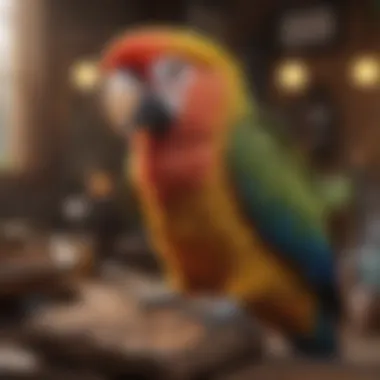
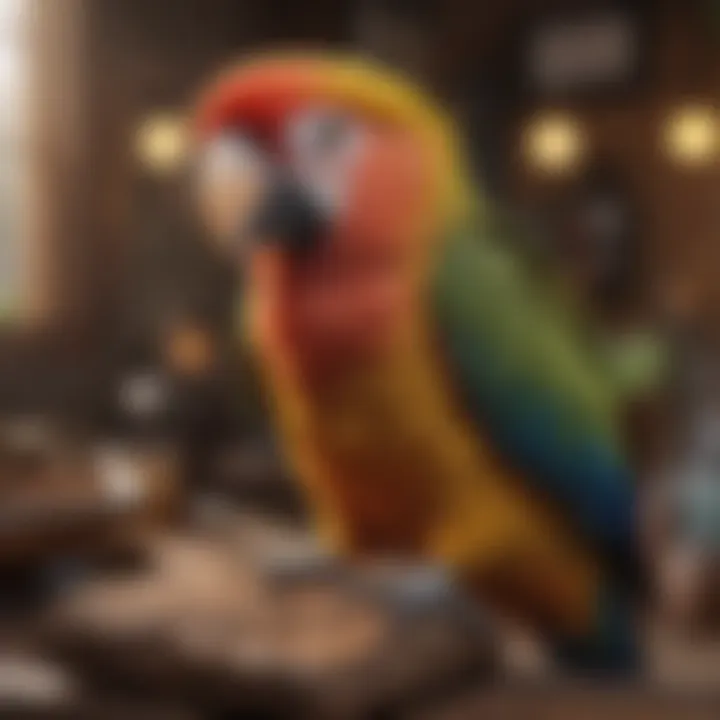
Choosing Appropriate Words and Phrases
Selecting the right words and phrases is fundamental in encouraging parrots to imitate speech. Parrots learn to speak by associating specific sounds with their meanings. This requires a focused approach to word choice.
- Simplicity: Start with simple. common words that are easy to pronounce. Words like “hello,” “goodbye,” or the name of the bird itself can serve this purpose well.
- Repetition: Emphasizing particular words during everyday interactions reinforces their recognition. Repeatedly saying “good morning” every time of day gives context to the word.
- Clarity: When uttering words, clarity is key. Speak clearly instead of mumbling words. Using distinct vocalizations will help the parrot catch and remember the sound.
In addition, it is crucial that the selected phrases be used during relevant contexts. For instance, saying “time to eat” before feeding can help the parrot associate the phrase with mealtime. This well-trained association aids in the gradual progressive learning of the putative language.
Utilizing Tone and Inflection
Tone and inflection play critical roles in how parrots interpret speech. Parrots are highly perceptive creatures who can detect vocal nuances.
- Parrot Receptiveness: Adjusting tone to match expression offers greater understanding. A high, excited inflection encourages engagement. Conversely, a softer, calm tone can provide assurance and comfort.
- Consistency: Just as with word choice, consistency in vocal tone during training helps reinforce learning. A gentle tone when saying “good bird” shows appreciation, which helps to build their confidence.
- Functional Inflection: Emphasizing certain words or sounds can be beneficial in training as well. When teaching commands, emphasize the key words using an authoritative tone if necessary to instill guidance.
It is noteworthy that familiarizing the parrot to sound diversions, inflection variations, and related inflections enhances their ability to discern speech patterns. Pairing this with positive behavioral acknowledgments reinforces its learning capability.
Using appropriate words and varied inflection builds the link between vocal sounds and rewards in a parrot's learning environment.
Understanding Parrot Behavior
Understanding the behaviors of parrots is essential to effectively communicate and train these intelligent birds. Parrots are not only skilled mimics, but they are also complex, social animals. Their ability to vocalize and form relationships with humans is enhanced by our grasp of their behavioral cues and needs. By recognizing these behaviors, owners can adapt their training methods, leading to positive interactions and successful communication.
Recognizing Signs of Engagement
Recognizing signs of engagement in parrots can significantly enhance the learning experience. Birds display interest and engagement in several noticeable ways, which can help owners determine the best times to interact and train. Common indicators include:
- Vocalizations: Increase in chirping or attempting human-like sounds signals interest.
- Body Language: Head bobbing or flaring of feathers generally exhibits a playful mood.
- Movement: Preening, climbing, or moving toward the owner demonstrates receptiveness.
Note that every parrot has its own unique personality, so these actions can vary widely. Pay close attention to your individual parrot's habits and behaviors to gauge its mood accurately.
"Understanding parrot behavior helps nurture a bond that fosters trust and respect."
Identifying Stress Indicators
It is equally important to understand when a parrot feels stressed. Stress can hinder a parrot's ability to vocalize and deprive it of joy. Recognizing potential stressors can help you maintain a healthy environment conducive to communication. Common stress indicators may include:
- Plucking Feathers: Self-destructive behavior related to untreated anxiety or environment.
- Excessive Squawking: Unusual noises could be signs of fear or discomfort.
- Hiding or Withdrawal: Withdrawal from interaction can signal distress or illness.
By actively monitoring these behaviors, owners can adapt their approach to ensure that their parrots feel safe and happy. Understanding the nuances of your parrot's behavior leads to a productive and fulfilling learning experience for both the bird and its human companion.
Common Challenges in Teaching Parrots
Teaching a parrot to talk can be a deeply rewarding experience, yet various obstacles frequently arise in the process. Understanding these challenges is crucial for any aspiring bird owner. Identifying potential hurdles early on can represent a significant advantage. Addressing reluctance to vocalize is often one of the main issues encountered. This reluctance can arise from several factors, including fear of the environment, immature vocal cords, or health-related concerns. By acknowledging the tosses and turns of the training process, a bird owner can structure their methods accordingly.
Moreover, another potential challenge often encountered involves handling behavioral problems. These may range from inappropriate screeching to unwanted biting. Recognizing the underlying causes is key. Perhaps the parrot seeks attention, or the stimuli surrounding it is overwhelming. These behaviors can impede the training process and understanding these problems will equip trainers with strategies to manage and redirect negative patterns into positive ones.
Addressing Reluctance to Vocalize
Reluctance to vocalize is a common experience many pet bird owners go through. Identifying the cause is essential. Parrots, being highly sensitive creatures, often express their discomfort through silence. Factors that can contribute to their reluctance include:
- New environments
- Previous trauma or rough handling
- Stress from other pets
- Changes in the household routine
To tackle this challenge, creating a familiarity with the environment is necessary. Offering a quiet space with minimal distractions allows the bird to settle comfortably. Encouragement is fat essential; some parrot owners find success in mimicking the sounds the bird naturally makes. Utilizing toys with attached sounds that can pique a parrot's interest can work wonders. Training through play can create an inviting atmosphere, making it less intimidating.
In many instances, gradual exposure is crucial. Slow introduction to vocal exercises helps. No parrot wants to feel overwhelmed. Therefore, focusing on short training sessions can result in better outcomes.
Handling Behavioral Problems
Behavioral problems can arise from various insecurities or stressors within a parrot's environment. Not understanding these behaviors can be detrimental to progress. Common warnings include aggression, biting, or sporadic screeches. Owners need to understand that ">addressing behavioral problems enables a conducive training environment. Failure to manage these behaviors could slow the learning process significantly.
A solution mindset offers helpful insights at this juncture. Try pinpointing possible triggers that lead to unwanted actions. Is the parrot showing signs of distress around specific stimuli? Attempt changing elements in its setting that may upset it, like rearranging furniture or changing the time of day for training.
Moreover, focusing on redirecting undesirable behaviors positively will create beneficial learning patterns. For instance, if biting occurs, assess the zone it happens in and safely redirect the parrot toward harmless alternatives like toys. Reinforcement techniques, like rewards or praise, when positive behavior is observed can slowly apply new patterns.
Handling behavioral issues adds significant layers to training, yet understanding these elements allows for more straightforward managing of potential setbacks. Fostering a trusting relationship through patience is vital, leading to an environment conducive to vocalization.
The Role of Consistency in Training
Consistency plays a crucial role when it comes to teaching parrots to communicate verbally. Without it, attempts at vocalization can become disjointed and unproductive. Just as humans need a structured learning environment, parrots benefit from an ongoing routine and clear expectations. When an owner implements a consistent approach, parrots are more likely to feel secure and motivated during training sessions.
A consistent training regimen fosters the learning process by establishing a familiar pattern that parrots can rely on. This approach does not just help in learning words but enhances the overall bond between the parrot and owner. Creating a shared experience adds to the trust, making it easier for the parrot to feel comfortable speaking.
Importance of Regular Practice
In the context of regular practice, repetition is invaluable. Practicing on a schedule leads to better retention. Parrots thrive on routine, and consistent intervals for training sessions provide the framework needed for them to absorb new sounds and words. Using simple phrases is beneficial during these practice times. An owner might say "hello" during feeding, playtime, or whenever they interact with the bird, reinforcing the association.
Researchers highlight that divinding practice into smaller, manageable periods is more effective. Training can sometimes becomes overwhelming if too many commands or words are introduced at once. Consistency not only helps with vocal training but also contributes to the development of a structured daily ritual. This includes:
- Morning greetings.
- Scheduled playtime interactions.
- Evening review sessions.
Keeping the sessions at around 10-15 minutes can maximize effectiveness without inducing fatigue.
Tracking Progress
Monitoring progress is equally important in enhancing training strategies. Having a clear understanding of how a parrot is learning will allow the owner to adjust their methods as needed. Simple documentation can be a powerful tool, including.
- Noting which words are successfully spoken.
- Whether new phrases are being consistently repeated.
- Identifying times and scenarios when the parrot feels more motivated to vocalize.
Additionally, owners should consider setting milestones. For example, if a parrot says a word brightly every day, that might indicate a solid grasp of that particular prompt. Creating a system for recognizing milestones shows the owner what works and where opportunities for improvement lie. Establishing criteria for successes, no matter how small they might seem, can boost both the parrots confidence and the owner’s motivation.
Consistent training coupled with monitoring progress leads to a more enjoyable experience for both parrot and owner. It enhances trust on both ends and provides a tangible framework for teaching.
The success of teaching a parrot to vocalize hinges significantly on the elements of repetition, practice, and advancement tracking. Adopting these practices can promote a more interactive and fulfilling relationship, encouraging the feathered companion into joyful communication.
Measuring Success in Parrot Training
Measuring success in parrot training is crucial for avian enthusiasts. It provides a tangible way to assess the effectiveness of the training methods used. As pet owners engage with their feathered companions, understanding what success looks like enables them to adjust their techniques. Every communication attempt from a parrot signifies its comfort and willingness to interact. Monitoring these breakthroughs helps educators appreciate the progress made and sets the stage for further development in their relationship.
Establishing clear and meaningful indicators counts significantly in this journey. Not all parrots vocalize at the same rate or with equal clarity. Therefore, a nuanced approach to success factors is essential. Implementing progress tracking fosters not only growth in the parrot’s speaking capabilities but also strengthens the bond between the parrot and its owner.
Key Indicators of Success
Monitoring key indicators is pivotal when teaching a parrot to talk. Effective assessments include both vocalization clarity and frequency.
Clarity of Speech: Observing how clearly your parrot pronounces words is fundamental. Pronunciation can evolve with time and might show changes based on the parrot’s mood.
Frequency of Vocalizations: A parrot that more consistently engages in vocal mimicry reflects a successful training session. It could be one new word a month or a short phrase being repeated without prompting.
Engagement during Training: If a parrot eagerly looks to its owner when lessons begin, this shows investment in the process. Noticeable reactions, such as tilting its head or displaying excitement, can demonstrate genuine interest.
Tailored Approach: Each parrot is unique. Some respond better to certain words, while others might show fondness for tunes. Adapting techniques to fit these traits often leads to clear indicators.
“Understanding your parrot’s uniqueness will aid in identifying those key indicators truly.”
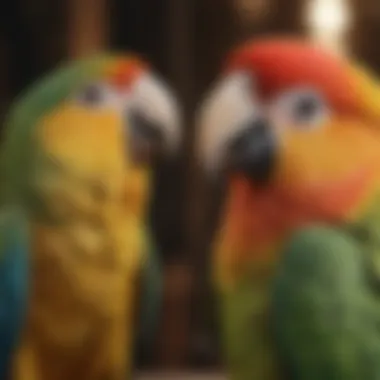
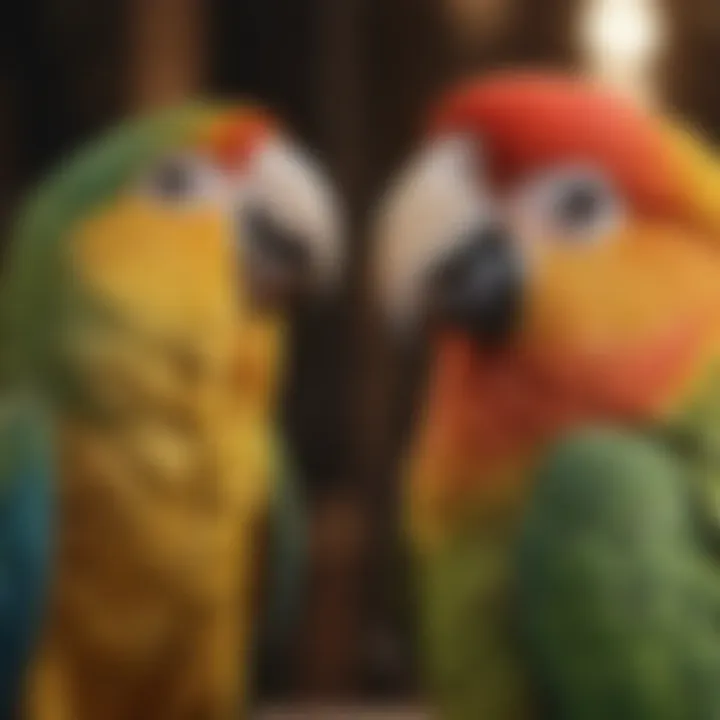
Setting Realistic Expectations
Setting realistic expectations is vital in parrot training. While aspirations may be high, it is important to keep in mind that talking ability varies widely across species and individual birds.
Age and Developmental Stages: Parrots often begin to vocalize at different ages, depending on their species. Younger parrots may take time to form solid language patterns, and patience is necessary during this.
Species-specific Abilities: Certain breeds have reputations for being exceptional talkers. African Grey Parrots, for example, are known for mimicking sounds accurately, while other species may excel in rhythm and pitch rather than mimicking verbal sounds accurately.
Small Goals: Divide training objectives into smaller parts to make the process manageable. Instead of aiming to teach a full sentence immediately, consider starting with a single word. Building on small wins fosters motivation for both you and your bird.
Ultimately, appreciating that progress embodies various forms—whether through imitated sounds or increased curiosity—will lead to a satisfying training experience. Celebrating these milestones allows trainers to stay motivated and reassensitive to each unique parrot journey.
Maintaining Motivation in Parrots
Motivation is a crucial aspect in teaching parrots to talk. Encouraging consistent communication requires strategies that keep these intelligent birds eager to participate. A motivated parrot will not only learn words and phrases more readily but will also retain this information longer. Understanding how to maintain motivation can lead to more effective training sessions and a stronger bond between you and your parrot.
Reward Systems
Creating a reward system is fundamental to maintaining motivation. Positive reinforcement provides an incentive for your parrot to vocalize. Rewards can come in various forms:
- Treats: Small, healthy snacks like pieces of fruit or nuts can work wonders. Make sure treats are something your parrot enjoys.
- Praise: Verbal affirmations or gentle petting can also serve as a form of reward. A parrot responds well to an enthusiastic tone.
- Toys: Providing new toys as a reward can keep the training exciting. Engage their curiosity through play.
For instance, when your parrot mimics a sound successfully, immediately follow it with a treat or praise. This helps to associate the action with positive outcomes. Again, Consistency is key here. The more regularly you utilize rewards, the more ingrained the idea will become.
Advanced Techniques for Experienced Owners
Advanced techniques can elevate the parrot training experience, distinguishing those with some level of experience and commitment from newcomers. As individuals learn more about their feathered companions, they explore methods that cater to the unique abilities of their parrots. While the basic training fundamentals are crucial, advancing beyond these opens new horizons, enabling both parrots and owners to engage in deeper interactions.
Additionally, gaining linguistic skills involves more than sheer repetition. Advanced strategies often require a careful balance of creativity, tech-driven tools, psychological insight, and substantial patience to guide parrots through complex vocal training.
Introducing Complex Sounds and Commands
Moving on from basic words, introducing complex sounds lays a foundation for enriched interactions and greater sophistication in communication. Parrots are remarkably capable of mimicking not only words but also nuanced sounds such as melodies or engine noises.
- Selectively Teach Sounds: Focus on sounds that resonate with you or hold relevance within your household. These become a part of your parrot's linguistic repertoire and contribute to a sense of connection.
- Techniques for Sound Introduction:
- Start with simple sequences, gradually increasing complexity.
- Use sound mimicry motivated by rewards. Repeat desired sounds consistently to reinforce learning.
- Be Mindful of Comprehension: Just as key to this process is feedback from your parrot. Monitor for signs of recognition or interest when practicing complex sounds, tweaking your training approach based on their responses.
A common issue is overloading the parrot with too many commands or sounds too soon. Keeping the learning environment calm and non-rushed encourages deeper focus and better retention.
Utilizing Tech Aids in Training
In the modern age, technology represents a valuable asset in enhancing parrot training techniques. Various available tools provide innovative ways to stimulate learning and refine vocal skills. Among these:
- Apps and Online Videos: Utilize mobile applications and instructional videos that train both you and your parrot. Setting daily lessons or engaging them through visual and auditory learning experiences can yield impressive results over time.
- Clickers: This tool can significantly aid in reinforcement training. Parrots respond well to distinct sounds. By clicking whenever desirable behavior appears, you associate good actions with clear feedback.
- Audio Devices for Repetition: Record phrases or sounds you wish your parrot to learn. This is particularly handy when trying to solidify a command they need to understand better.
Taking advantage of these tech aids fosters diverse enrichment activities. Incorporating tools instead of solely traditional vocal reinforcement helps are valuable in teaching. It boosts mental stimulation while ensuring repeat learning conditions.
Master the integration of tech tools in your training regimen to enhance overall effectiveness, engagement, and bonding experiences between you and your parrot.
For experienced owners, embodying these advanced techniques assures a more gratifying path in the journey of teaching parrots to communicate. The emphasis on blending creativity, patience, and tech support amplifies the potential in every squawk and chortle reverberating through your home.
Ethical Considerations in Parrot Training
Teaching a parrot to talk requires not only skillful techniques but also a keen awareness of ethical considerations. Since parrots are intelligent creatures with rich emotional lives, the manner in which we train them must align with their welfare. This section emphasizes the ethical dimensions of training as essential for ensuring positive outcomes in both learning and bonding between the birds and their owners.
Understanding Animal Welfare
Animal welfare is a central concept in parrot training. A welfare-oriented approach considers the physical and psychological needs of the parrot. First, owners should ensure a appropriate diet, nutrition, and housing conditions. Parrots that live in enriched environments, with ample space to fly, chew, and explore, are more likely to be engaged learners.
Parrots require mental stimulation. Boredom can lead to stress or undesirable behaviors, making training more challenging. To keep their minds active, owners can provide interactive toys, puzzles, or opportunities for socialization with other birds or humans. By incorporating these elements, pet owners contribute directly to the bird’s readiness to learn new words and phrases.
Furthermore, monitoring their comfort during training sessions is essential. A parrot unwilling to engage typically signals stress or dissatisfaction. Recognizing signs of discomfort, such as squawking, biting, or excessive feather ruffling, should prompt a reassessment of the training method.
Avoiding Coercive Methods
When teaching parrots, it’s vital to avoid coercive training methods. Coercion can undermine trust and interfere with the establishment of a respectful bond. Instead of imposing fear or stress, training should foster a safe and trusting environment. This means using gentle techniques that respect the bird's autonomy while facilitating learning.
Some effective techniques include:
- Positive Reinforcement: Rewarding desired behaviors encourages parrots to repeat them. This method builds confidence and reinforces the owner-bird relationship. Treats, praise, or affection are excellent examples of rewards.
- Patience and Understanding: Training a parrot takes time. Each bird learns at its own pace, and pushing too hard can backfire, leading to resistance or fear. Observe progress and adjust training intensity accordingly.
- Setting Realistic Goals: Establishing achievable training milestones keeps both the owner and the parrot motivated, preventing frustration that could arise from unreachable expectations.
“The ethics of training must remain a commitment to nurturing a bond based on trust and respect.”
Effective training methods that embody ethical treatment also promote happier and more communicative parrots. As avian enthusiasts, we have a moral responsibility to ensure that our teaching methods respect both the cognitive capabilities and emotional well-being of our feathered companions.
Resources for Parrot Owners
Understanding how to care for a parrot involves access to a myriad of resources. Proper information can transform your experience as a parrot owner. The section focuses on important resources including books, scholarly articles, and online communities. These resources aid in expanding knowledge about parrot behavior, meditation, training, and handling issues effectively. Engaging with other owners also allows for sharing of personal experiences and solving common problems.
Recommended Books and Articles
Books and scholarly articles encapsulate ideas and studies that can deepen one's understanding of parrot behavior and training methods. Key references include:
- The Parrot Who Thought She Was a Dog by Bruce Campbell - A fascinating exploration of parrot intelligence and personality.
- Birds of Color: How To Stay Happy and Healthy by Jeffrey S. Sreenivasan - A blend of avian science with practical tips for guardians.
- Articles in journals like the Journal of Avian Medicine and Surgery - These often provide in-depth research findings relevant to parrot health and behavior.
Having a collection of engaging, evidence-based literature inspires the owner. They offer comparative discussions about different parrot species, feeding strategies, and breakthroughs in behavioral training.
Online Communities and Forums
Online communities act as invaluable hubs of shared knowledge. These platforms allow members to exchange experiences and solutions regarding parrot care.
Platforms such as Reddit and Facebook offer strong networks. Here are some specific benefits:
- Networking with like-minded individuals who have similar interests.
- Access to personal stories and tactics from seasoned owners that may not be available in standard care literature.
- Opportunities for learning through interactions and discussions on topics like training, feeding, or veterinary care.
These interactions can support your efforts in parrot communication and care, enhancing overall understanding through community engagement.
Epilogue and Future Directions
Reflecting on the Training Journey
Teaching a parrot to talk is more than just a training activity. It involves a profound relationship founded on trust, patience, and mutual respect. Every attempt at communication enhances the bond between the owner and the parrot. As one navigates the complexities of vocalization, it is essential to note that each parrot is distinct. This individuality can greatly affect the training process. Owners should reflect on both the progress achieved and the challenges faced.
It's wise to celebrate small victories during training. For example, when a parrot mimics a sound or word, this marks a crucial step forward. Recognition of these moments reinforces the owner-parrot connection. Furthermore, there should be consideration of the processes involved, including daily routines and specific training sessions, which play significant roles in the overall journey.
Recognizing milestones and being honest about areas for improvement can provide satisfaction and motivation. The training journey underscores not only the parrot's learning but also the owner's growth as an effective teacher. Reflecting on this dynamic can foster a deeper appreciation for the capabilities and unique personalities of these intelligent birds.
Encouraging Ongoing Learning
Learning is an endless process, especially in the realm of parrot training. The journey does not finish with a parrot vocalizing occasional words or phrases. Instead, owners have the opportunity to continually enhance this skill and take deeper dives into understanding behavior and communication dynamics.
Moreover, engaging with communities such as forums on Reddit or Facebook can encourage further exploration and sharing of experiences. These platforms are valuable resources where people can exchange tips and strategies that relate specifically to bird behavior and training.
Consider exploring more advanced techniques or even alternative forms of communication, such as using sounds or clickers for training. Staying updated with literature on avian behavior and effective teaching methods can broaden perspectives and improve training efficacy.
Ongoing engagement in learning solidifies not only the bond between parrot and owner but also fosters a deeper understanding of avian life and behaviors. This commitment to growth transforms pet ownership into a more enriching pursuit, for both the human and the parrot.















